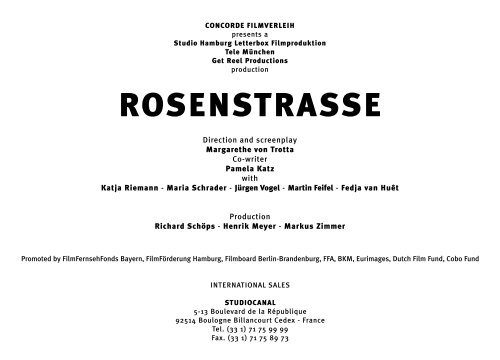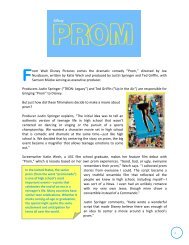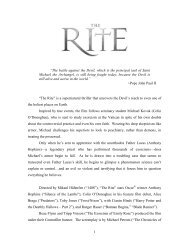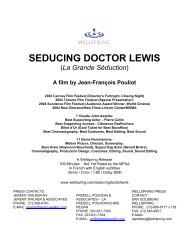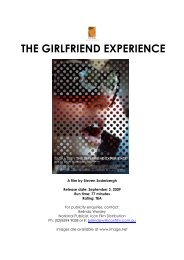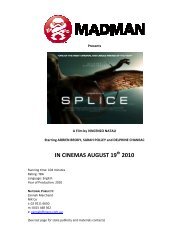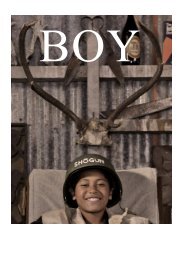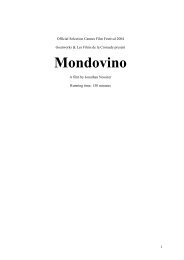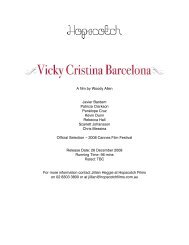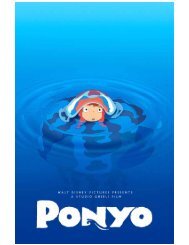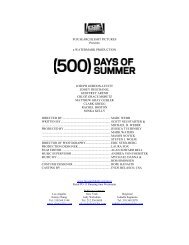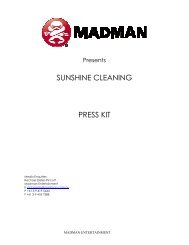ROSENSTRASSE
ROSENSTRASSE
ROSENSTRASSE
You also want an ePaper? Increase the reach of your titles
YUMPU automatically turns print PDFs into web optimized ePapers that Google loves.
CONCORDE FILMVERLEIH<br />
presents a<br />
Studio Hamburg Letterbox Filmproduktion<br />
Tele München<br />
Get Reel Productions<br />
production<br />
<strong>ROSENSTRASSE</strong><br />
Direction and screenplay<br />
Margarethe von Trotta<br />
Co-writer<br />
Pamela Katz<br />
with<br />
Katja Riemann - Maria Schrader - Jürgen Vogel - Martin Feifel - Fedja van Huêt<br />
Production<br />
Richard Schöps - Henrik Meyer - Markus Zimmer<br />
Promoted by FilmFernsehFonds Bayern, FilmFörderung Hamburg, Filmboard Berlin-Brandenburg, FFA, BKM, Eurimages, Dutch Film Fund, Cobo Fund<br />
INTERNATIONAL SALES<br />
STUDIOCANAL<br />
5-13 Boulevard de la République<br />
92514 Boulogne Billancourt Cedex - France<br />
Tel. (33 1) 71 75 99 99<br />
Fax. (33 1) 71 75 89 73
Synopsis News Release<br />
Ruth Weinstein (JUTTA LAMPE), a New York woman, has just<br />
buried her husband. In her grief she ponders her orthodox Jewish<br />
religion, and arranges a 30-day mourning period for the whole<br />
family. What is more, she disapproves of the marriage of her<br />
daughter, Hannah (MARIA SCHRADER), to the South American Luis<br />
(FEDJA VAN HUÊT). Hannah has no idea what could be causing<br />
this obstinate behaviour. In order to find out why her mother is<br />
behaving so strangely, Hannah makes her way to Berlin to look for<br />
clues. There she gets in touch with the now 90-year-old Lena<br />
Fischer (DORIS SCHADE), who finally breaks the wall of silence.<br />
As a young woman, Lena Fischer (KATJA RIEMANN) had come<br />
across the little girl called Ruth in a street in Berlin by the name<br />
of Rosenstrasse. This was the place where, in 1943, hundreds of<br />
women had gathered to demonstrate against the deportation of<br />
their Jewish husbands, who were imprisoned there at the Jewish<br />
Welfare Office. Lena was looking for her husband Fabian (MARTIN<br />
FEIFEL), and Ruth for her mother. After a despairing struggle with<br />
the National Socialist authorities in which Lena’s brother Arthur<br />
(JÜRGEN VOGEL), an astonished army officer, also became involved,<br />
the incredible actually happens.<br />
The prison gates open and, like many other women, Lena is<br />
indeed able to embrace her beloved husband once again. But<br />
Ruth’s mother remains missing, and so Lena takes little Ruth<br />
under her wing, thus saving her life amongst the turmoil<br />
of the last few years of the war……<br />
With an impressive ensemble of first-class national and international<br />
actors led by Katja Riemann (The Pharmacist), Maria Schrader<br />
(Aimée and Jaguar) and Jürgen Vogel (Life is All You Get), the<br />
renowned and multiple prize winning filmmaker Margarethe von<br />
Trotta (Rosa Luxemburg, Marianne and Juliane: The German<br />
Sisters) tells this authentic abridged story of events that took<br />
place in Berlin during 1943. What happened there was a result of<br />
the courage of a handful of committed women and saved many<br />
from a certain death. Rosenstrasse is a lavishly produced drama<br />
about friendship and solidarity with an instinct for historical<br />
detail, an impressive example of unconditional love.
Production Notes<br />
In the same way that the events that took place in Berlin’s<br />
Rosenstrasse about 60 years ago were remarkable and almost<br />
unbelievable, the story created by Margarethe von Trotta for the<br />
film of the same name is thrilling and exciting. It begins with a<br />
conversation between Richard Schöps, Markus Zimmer and Henrik<br />
Meyer, producer of Rosenstrasse Schöps reminisces: “In the year<br />
2000 in Berlin I met Margarethe von Trotta for the first time. She<br />
told me about the Rosenstrasse story, which I had never heard of<br />
before then. I was quite taken with it, finding the material great.<br />
I particularly liked the women’s protest, which was unique.”<br />
Volker Schlöndorff had already tried to get the project off the<br />
ground in 1995 when he was head of Babelsberger Filmstudios.<br />
After he had made it clear that he had no objections to tackling<br />
the material once again, in October 2000 the screenplay promotion<br />
was submitted to the FFA (Filmförderungsanstalt, or German<br />
Federal Film Board), where it was promptly accepted. Moreover,<br />
an ideal production partner was found in the Tele-München-Gruppe.<br />
Richard Schöps recalled that “Henrik Meyer had prepared a meeting<br />
in Munich and we presented our request to Markus Zimmer. He<br />
was immediately very enthusiastic about the idea and spontaneously<br />
accepted.”<br />
No compromises on the budget<br />
When preparations for the production were underway, it quickly<br />
became clear that such an expensive project could not be realized<br />
with German promotional funds alone. The filmmakers nevertheless<br />
initially tried to make the budget structure as clear as possible,<br />
which was a challenge for this kind of story about a protest that<br />
had to be told in images, thus needing large numbers of extras<br />
and people with minor parts. So this was no easy task for the<br />
producers. “It was also difficult to find a suitable set. Then, in a
former textile town, we did find suitable themes. And there was,<br />
of course, also the street in Babelsberg in which Sonnenallee and<br />
The Pianist were shot. And that was in fact Trotta’s preferred set.<br />
On top of all that, we had to have an unscathed Rosenstrasse as<br />
well as a badly damaged one, as the first bombs fell on Berlin in<br />
March 1943. Margarethe von Trotta was very keen for that to be<br />
portrayed realistically. So there wasn’t much scope for flexibility<br />
as far the budget was concerned.”<br />
Eventually, Markus Zimmer managed to spark the Dutch company<br />
Get Reel Productions, the workplace of the two young producers<br />
Errol Nayci and Volker Struycken, with enthusiasm about<br />
Rosenstrasse. By the end of May 2002, the budget now stood at<br />
6.5 million euros making it possible to enter the real preparatory<br />
phase. While for the main cast Katja Riemann and Maria Schrader<br />
had been the production teams’ favourites for some time, other<br />
major parts as well as numerous minor roles had yet to be filled.<br />
On this subject, Schöps said “There was an extensive casting with<br />
Sabine Schroth. During the course of that, we quickly came across<br />
Jürgen Vogel. And then the more minor roles were taken by absolutely<br />
top-notch actors. That has also added to the quality of the film.”<br />
“We also thought about something special in regards to the<br />
Rosenstrasse layout.” The 1940s should be shown in a different<br />
shade of colour than the present day. Franz Rath, Margarethe von<br />
Trotta’s cameraman with many years experience, had the idea of<br />
bleaching the scenes out and then copying them. The producer’s<br />
courage was thus also tested, as he remembers with trepidation,<br />
“There is, of course, no guarantee for this work from the company<br />
doing the copying or from the raw film supplier. We nevertheless<br />
took this risk. To begin with I was quite careful, but then the first<br />
few samples convinced me. Because this is exactly what gives the<br />
film its unique look.”
Unique picture and sound aesthetics<br />
Special attention was also paid to the sound. This was because<br />
the mixing of the flashbacks was not compiled as realistically as is<br />
usually the case. The reason for this is that the filmmakers believed<br />
that sounds, noises and atmospheres are perceived differently in<br />
memories. That was why in Rosenstrasse, doors may have slammed<br />
shut more loudly than was realistic. This a question of so-called<br />
remembered images. The director and her team wanted to use this<br />
method to demonstrate that a theme can be incorporated not only in a<br />
historical and documentary way, but also aesthetically and artistically.<br />
The Rosenstrasse street that was constructed on the open terrain<br />
of the Babelsberger Studios was not in fact true to the original<br />
one, but its style nevertheless corresponded to the 1940s. Here,<br />
the filmmakers confronted with a further challenge, i.e. the lighting<br />
arrangements, as it was not possible to have the full moon shining<br />
constantly. So helium filled balloons were used to give the street<br />
a “discreet, soft light”.<br />
As always with a production on this scale, the Rosenstrasse team<br />
had to struggle against the adversity of the weather. Schöps said,<br />
“It was October 2002. Sometimes it rained, sometimes the sun<br />
shone. We had a street of houses upon which the setting sun lit<br />
up the set from a certain angle every day. At that point we had to<br />
stop working systematically, but what made things worse was that<br />
at this time of year, from four in the afternoon there is virtually no<br />
more daylight available. But the team also managed to overcome<br />
this problem magnificently.”<br />
At times, up to 500 extras had to be moved during a single day’s<br />
shooting of Rosenstrasse. The make-up and wardrobe departments<br />
had to start work as early as five in the morning if they were to<br />
stand any chance at all of getting through their work quota. Here<br />
too, Margarethe von Trotta relied on colleagues she had worked
with successfully on earlier projects. One of those was costume<br />
designer Ursula Eggert, who also proved herself this time around.<br />
Masterly performance of organization and logistics<br />
Because almost all the major German promotional institutions<br />
played a role in the financing of the film, special consideration<br />
had to be given to the logistics. Schöps remembers “We wanted to<br />
have a united crew. In this respect, from the start we put together<br />
a team of people from Munich, Hamburg and Berlin. We only<br />
replaced personnel in a very small number of positions. Only a<br />
small team went to New York, but still included our make-up<br />
artists and equipment personnel. Fulfilling all the different<br />
regional effects was also a real puzzle. The Dutch co-producers<br />
also provided a variety of means for the project. Not only did their<br />
countrymen fill some of the succinct minor roles, but they also<br />
took charge of the music. They brought in the 90-musician<br />
Hilversum Orchestra.<br />
The recordings were completed in only three days.<br />
54 red roses for the director<br />
The shooting of Rosenstrasse was completed on 18th December<br />
2002 in Munich on schedule after exactly 54 days of shooting. The<br />
producers had thought of something very special for this day. “We<br />
wanted to present Margarethe von Trotta with 54 red roses and<br />
one white one. So we asked the recording manager to tell us when<br />
the last clapperboard would fall, because we absolutely wanted to<br />
be there at that time. On the last day, by 11 am he called us, saying<br />
he thought that the last clapperboard would fall in just five minutes<br />
time. And we had expected it to be at 7.00 pm. We asked him to<br />
delay everything a little, and we were then able to make the<br />
ceremonial presentation of the enormous bouquet of roses.”
Margarethe von Trotta<br />
on Rosenstrasse<br />
The Rosenstrasse project has been accompanying you for<br />
the last ten years… How and when exactly did it all begin,<br />
and how did you get the material for it?<br />
Between the end of 1993 and the beginning of 1994 when<br />
I was editing The Pledge at the Studio Babelsberg, Volker<br />
Schlöndorff, who was then still in charge of the studios,<br />
came to me with the story, and at the same time he<br />
introduced me to Daniela Schmidt, who had made a film<br />
documentary called Resistance in Rosenstrasse, Berlin 1943,<br />
who I did not know until then. Daniela was very easy to<br />
approach, and, because she had made friends with some of<br />
the contemporary witnesses she’d interviewed for her film,<br />
she seemed to me to be close to the idea that a movie would<br />
also be made about the events in question.<br />
She rightly thought that these events were much too<br />
little-known, but that they would deserve being exploited.<br />
She made it clear to me that she was willing to let me use<br />
all the material and interviews that she had done with the<br />
Rosenstrasse contemporary witnesses, and which she<br />
had recorded in writing, since unfortunately not everything<br />
can be used in a film. Through her mediation, I then<br />
met ten people and questioned them. It was only after<br />
these impressive personal encounters that I really<br />
became motivated.<br />
How did things then progress? Did that result in you writing<br />
the first screenplay version?<br />
Yes I remember how – in the summer of 1994 – I wrote the<br />
first pages in the Berlin Academy, as I was living in Berlin<br />
at the time. That was still a very simple, chronologically told<br />
story, initially only dealing with the time after 27 February,<br />
the day of the latest major raid on Berlin and on which the<br />
remaining Jews were taken from the factories and from<br />
their homes to five refugee camps, one of which was<br />
in fact in Rosenstrasse, until 5 and 6 March, when the first<br />
ones were released. And at the same time, I went to see the<br />
places where all this had happened. Of course, most of<br />
these were no longer there, only the streets, and occasionally<br />
a memorial such as the one in Levetzowstrasse, the place<br />
where, strangely enough few people realize, Berlin’s largest<br />
synagogue once stood.<br />
In addition, I read endless literature, which is something<br />
I do for every film, and I feel it is a great privilege, and even<br />
a pleasure, had it not been as painful as it was in this<br />
particular case. The history of the Jews, the history of the<br />
Jews in Germany, the history of National Socialism, books<br />
by Lien Feuchtwanger, Primo Levi, and Elie Wiesel, to name<br />
but a few of the writers… Sometimes I was really unable to<br />
continue because the reading had taken such a toll on me…<br />
Of course, I already knew most of the facts, but it’s different<br />
when you know that you have to learn it in order to be able<br />
to portray it. That doesn’t mean, of course, that I had to<br />
reconstruct Auschwitz as Spielberg did in Schindler’s List,<br />
but I did have to go through everything. I then also went<br />
to Auschwitz, which is something I had always feared.
I learned from one of the contemporary witnesses that 25<br />
men who had already been taken there from Rosenstrasse<br />
were brought back following the release of the others. But<br />
they were not handed back to their wives directly, rather<br />
imprisoned in another camp near Berlin, which at least<br />
was not an extermination camp.<br />
The financing is not supposed to have been easy...<br />
When the screenplay was ready, Volker Schlöndorff in<br />
Babelsberg had the figures worked out, and the budget<br />
came to ten million German marks. That was expensive,<br />
and he asked me to reduce it. That could only be done by<br />
scrapping some of the scenes, so I had to take a completely<br />
different approach for the second version. That was when<br />
I came across the story of the little girl called Ruth,<br />
a character I’d discovered in another film documentary<br />
called Liberation from Rosenstrasse by Michael Muschner,<br />
whose mother was imprisoned at Rosenstrasse and<br />
who had managed to speak to her mother briefly,<br />
and her meeting Lena, which was another of the facts<br />
uncovered by the film. Whereas the first version<br />
described the general situation in the city and dealt<br />
with many different people, I now tried to reduce the events<br />
to a handful of people. That suited me better. In my films,<br />
I usually deal with individual people and their personal<br />
destinies, since history actually occurs within the private<br />
lives of the characters. I have always been fascinated<br />
by the way people cope with the time and the point<br />
in history in which they find themselves, which of course,<br />
they cannot choose themselves. Will they simply become<br />
victims, or will they try to find an escape from the role<br />
of victim? In this respect, I was in fact quite lucky to have<br />
to change the screenplay.<br />
In 1995, the screenplay was submitted to several promoters<br />
by Studio Babelsberg, but was promoted nowhere. For at<br />
least two years, we believed that we could still manage it<br />
somehow, in the spring we said we would be shooting in the<br />
autumn, and in the autumn we expected to be shooting in<br />
the spring, but nothing happened. What did happen is that<br />
I travelled to Poland in search of a set, to see whether we<br />
could shoot there with the help of a Polish co-production<br />
company, but in vain. In the end, all the participants knew<br />
that we wouldn’t do it, and we gave up. In the winter of 1996<br />
we thought we had buried the project forever…<br />
Then the TV films began with Winterkind (1997) followed<br />
by Dunkle Tage (1998) up to the four-part mini-series<br />
Jahrestage (2000)…<br />
...yes, that was what saved me. And I’m still grateful today to<br />
Gunter Witte (formerly WDR) and Martin Wiebel (dramatic<br />
advisor) that they suggested shooting Winterkind to me.<br />
Until then I had turned down making a television film in an<br />
unjustifiably arrogant way. But today it’s clear that that was<br />
the turning point, as television enabled me to survive and<br />
also to learn. It is very demanding to have to cope with less<br />
money and with far fewer filming days than in the case of a<br />
film for the big screen. That was very salutary. After a large<br />
budget such as the one I had had for The Pledge, still to be<br />
able to bake a good cake with few ingredients enjoyed by<br />
the guests!
… After that, it was a relief simply to be able to do cinema<br />
once again as usually you only get one opportunity to…<br />
and the big screen was the beginning of our dream, and<br />
we became directors in order to realize that dream.<br />
Finally, in 1999, Martin Wiebel had brought the material<br />
back from the dead. He had previously made Gloomy Sunday<br />
with the producer Richard Schöps of Studio Hamburg Rolf<br />
Schübels. And he believed that now was probably a more<br />
convenient time to make Rosenstrasse than earlier during<br />
the German “Comedy Period”. He also believed that,<br />
following the change of government in 1998, it was possible<br />
to detect a recognizable change in the way the Nazi past was<br />
dealt with, namely in the form of compensation for forced<br />
labour. That also raised my spirits. Studio Hamburg decided<br />
to take part, which surprised me because it chiefly makes<br />
material for television, but I think that Concorde-Filmverleih,<br />
which had already made three of my films (Rosa Luxemburg,<br />
Fear and Love, and The Pledge) proved decisive.<br />
I once again wrote a completely new version, based on the<br />
old ones and reduced but broadened by a connection with<br />
the present, which begins in present-day New York. In the<br />
meantime I had read about how the subject of the Holocaust<br />
had been avoided in the years since the end of the Second<br />
World War, about how people dealt with the question there,<br />
how, as a survivor, you were not allowed to talk about it,<br />
how you had to simply forget the past as quickly as possible<br />
and look towards a “bright American future”. So the effort to<br />
forget was almost as great as ours, with the exception that,<br />
in the case of the Americans, it was likely to have been<br />
a result of the “positive thinking” attitude.<br />
Only very gradually, similarly to here in Germany, consideration<br />
of what had been done to the Jews in Germany began, and<br />
ended with the opening of a Holocaust Museum in almost<br />
every large town or city. The Jews who went there from<br />
Europe, like Ruth, the little girl, after the war, were therefore<br />
expected to forget. The problem was that, for such<br />
overwhelmingly painful memories there is no forgetting,<br />
only suppression, so Ruth had to suppress her memories,<br />
and the new pain she now had to suppress in the form<br />
of the loss of her husband brought the suppression back<br />
into the conscious mind in an almost shocking way. The film<br />
now begins with this memory shock.<br />
I asked Pam Katz (screenplay writer, wife of cameraman<br />
Florian Ballhaus) to contribute to the writing for the<br />
American part as co-writer. Pam lives in New York and<br />
it was extremely helpful to work with her. She is a real<br />
workaholic, enthusiastic and at the same time critical, and<br />
her suggestions went far beyond the purely American part.<br />
After all these obstacles and difficulties – what really<br />
spurred you to make this film?<br />
There are many different aspects, and you can, of course,<br />
never explain exactly why you want to make a film. We<br />
should begin with the rational aspect; I first ask myself what<br />
has happened in my own biography or film script. I once,<br />
perhaps thoughtlessly, announced that by the end of my film<br />
career, I wanted to have described the whole of the 20th<br />
century. Rosa Luxemburg had already taken me up to 1919.<br />
With Jahrestage I had dealt with the periods before and after<br />
the war. I portrayed 1968 and the 1970s in Marianne and<br />
Juliane: The German Sisters. The Berlin wall years between
1961 and 1989 were the theme of The Pledge. What was<br />
missing from my “20th century collection” was a film<br />
dealing with the greatest damage from Germany’s darkest<br />
period, a film telling the story of the Nazis’ extermination<br />
policy. The Angelus Novus, the Angel of History from Walter<br />
Benjamin’s The Making of Paul Klee's Career, which turns<br />
to face history, but from the storm of progress, was<br />
important to me.<br />
But, above all, the resistance of the women of Rosenstrasse<br />
was almost virtually unknown until 1989, it was a forgotten<br />
miracle of the courage of the women’s convictions. The fact<br />
that these women had lived through the uncomfortable<br />
truth, even though the alternative of turning away or of<br />
taking part existed, had led to their resistance remaining<br />
forgotten. Sixty years after these events it was important<br />
to express this incredibly steadfast loving honour.<br />
Rosenstrasse lies in the centre of Berlin…<br />
...it’s a small street close to the Alexanderplatz. The oldest<br />
synagogue in Berlin stood in Heidereuthergasse, a narrow<br />
street that turned off Rosenstrasse, at that time. And, in<br />
Rosenstrasse itself, there was a Jewish Community Welfare<br />
Office which, at the time when the film was set, had been<br />
converted into a refugee camp.<br />
The unusual thing about Rosenstrasse was the success<br />
of these women. The fact that they gathered and protested<br />
there at all is totally impossible to imagine in the face<br />
of the history of National Socialism, and the fact that<br />
these were women protesting once again comes back<br />
to a personal aspect: my films are usually about women,<br />
that’s my prison!<br />
On the one hand, the women who voted for Hitler at the time<br />
were in the majority. Without them, he may not have come<br />
to power. They had surrendered to him like a bridegroom,<br />
just like religious women in the Middle Ages who worshipped<br />
Jesus as their bridegroom. Hitler’s success was to a large<br />
extent based on this love, the dedication and enthusiasm<br />
of German women. And on the other hand, in Rosenstrasse<br />
there were uncompromising women who were protesting<br />
against him and fighting for their Jewish husbands.<br />
This contradiction, the age-old German virtue of loyalty –<br />
which over the years, has sometimes been applied to<br />
undeserving causes – and these women were immeasurably<br />
loyal; which was one of the reasons why the soldiers<br />
in Rosenstrasse could not easily shoot at them.<br />
The only thing they could do was to try to intimidate them.<br />
After all, these were Aryan women who had always done<br />
and fulfilled exactly what was asked of them: to be loyal<br />
to their husbands.<br />
This is possibly the heart of the matter: i.e. that this was<br />
not a political demonstration in the usual sense. These<br />
women did not intend to act as a political group, but each<br />
of the women was in search of her own husband, and each<br />
of them had finally arrived in Rosenstrasse. And had stayed<br />
there. The individual proof of love of each and every woman.<br />
Moreover, they did not see themselves as heroines, they<br />
were afraid, they were in despair, their courage was a result<br />
of their despair and they reacted as one would react in an<br />
extreme situation, in a way that, under other circumstances,
they would have been incapable of acting.<br />
Nobody has ever been able to explain to me how they all<br />
came to be in Rosenstrasse, but what is certain is that the<br />
authorities had given them no information. It has been said<br />
that they used the so-called Mundfunk, or grapevine, to pass<br />
information on by word of mouth. It seemed to me that they<br />
were all telepathically linked to their husbands and that<br />
they were attracted to them as if by a force field.<br />
...there is a Trotta-style leitmotif in many of your films, and<br />
this is also the case here: the personal story of the individual<br />
woman becomes history in a more general way….<br />
...yes, that’s exactly what makes me act time and time again.<br />
I don’t even know myself why this is what always happens,<br />
particularly as in this case I was “drawn” to the theme, it<br />
didn’t come from me, but it was suggested to me from outside.<br />
I still remember how it was in the case of Rosa Luxemburg,<br />
and at the time the actor Jan-Paul Biczycki, who has played<br />
parts in a few of my films and whom I called my guardian<br />
angel, said to me, “Your film is already written into the<br />
universe.” That was a year before we started shooting!<br />
There is perhaps another reason why I wanted to make the<br />
film. Memory. I’ve always been very curious as to how it<br />
works. And here I am able to demonstrate that there are two<br />
different types of memory. There is Ruth, who is overcome by<br />
it in a moment of defencelessness, who had spent a lifetime<br />
successfully suppressing it. She is still suffering the pain<br />
because for her, memory is linked to a deep wound. On the<br />
other hand, there is Lena. She readily tells her story “as if it<br />
all happened yesterday”. For her, memory is that of a victory<br />
(even if it was only a “small ray of light at a very sinister<br />
time”), and therefore she does not need to suppress what<br />
she experienced, her memory is light and the shadows are<br />
only a result of the epoch, they do not come from within her.<br />
Nobody knows either approximately how many women were<br />
present, nor why in the end they escaped together with their<br />
freed husbands.<br />
No, the evidence about all that varies a great deal, even<br />
according to the contemporary witness with whom I’ve<br />
spoken. The numbers range from 150 to 1,000. Wherever the<br />
events in Rosenstrasse are written about I find different<br />
figures. There is no way of checking the information. What I<br />
wanted to show above all was that to begin with there were<br />
very few of them, and that as the days went by, the numbers<br />
grew and grew, that to begin with they were silent, but that<br />
they suddenly began to express their protest in words, that<br />
the more they were obliged to give up hope, the louder their<br />
protests became.<br />
The same is true of the very reason why those in custody<br />
were finally released. Up to now, no historian has been able<br />
to establish any solid proof on this subject. Here again,<br />
opinions vary widely. Many, even most of the contemporary<br />
witnesses believe that the women were indeed responsible,<br />
and far fewer believe that it was thus planned from the<br />
outset, so that the prisoners could be categorized in such a<br />
way that those with no Aryan partner or relatives who were<br />
due to be deported could be used as replacements in<br />
bureaucratic positions. But if this were indeed the case,
I wonder why so many children were also interned, 14-year-olds,<br />
who would have been too young to fill the positions. So there<br />
are uncertainties and contradictions – which nevertheless do<br />
not belittle the courage of the women.<br />
Their story is and remains one of the courage of their<br />
convictions, since they must have assumed that the<br />
prisoners were destined for Auschwitz or another camp.<br />
They all knew more or less for certain that “the East” did not<br />
offer brilliant chances of survival. In this respect, the women<br />
on the outside, as well as the men on the inside, were<br />
justifiably afraid. And the fact that, despite their fear, these<br />
women did not allow themselves to be driven away, is for me<br />
the most important and exemplary aspect of the whole story.<br />
How close are you to true destiny and to what extent has<br />
fact been transformed into fiction?<br />
A film director, unlike a historian, must tell a story, a fiction,<br />
about a historical event such as Rosenstrasse, upon which<br />
we have built up reports of experience and participation,<br />
facts and questions, varying details and points of view, on<br />
the basis of the facts. My Rosenstrasse does not attempt<br />
to reconstruct reality in a documentary play. I have put<br />
together and offered my own view. It was by no means<br />
clear from the outset which people and facts the film story<br />
would portray.<br />
But when you delve back into history, it has to be re-lived.<br />
I never make a film simply for the sake of history. No, I<br />
always have to discover and bring out the things that<br />
interest us and touch us as people living in the present.<br />
I believe this is the only way to make a historical film<br />
interesting.<br />
There are, of course, transformations. For example, I used<br />
several real people to play a single character, thus moving<br />
the people around, then I brought them back and developed<br />
new characters. This makes the situation authentic, and<br />
everything that happens to the people has in some way<br />
already happened, even though the characters are fictitious.<br />
...is there a form of identification for yourself amongst all this?<br />
Lena, possibly?<br />
No, in fact there isn’t, they are all equally close to me. It is<br />
the same as in most of my other films. I always feel that I<br />
must divide myself up into two or three women as one<br />
woman would not be able to bear my many contradictions.<br />
So there are many characters to represent what you are<br />
yourself, what one experiences personally. Rosa Luxemburg<br />
was possibly the only exception to this, where all these<br />
contradictions came together in one person – power and<br />
weakness, anger and fear.<br />
It would, of course, be obvious to equate me with the<br />
character of Lena in this film, the aristocratic woman who<br />
brings her hereditary arrogance with her, who shows<br />
strength but who is also helpless because of love and the<br />
will to save her husband. She initially breaks down after<br />
having seen Goebbels, when she exposes herself to<br />
humiliation, which does not bring her success. At that point,<br />
her identity is undermined. Going to Rosenstrasse lifts her<br />
up, but going to Goebbels brings her down.
Then there is Klara, the office worker, who, unlike Lena, does<br />
not have a brother to help her, who has no-one to support<br />
her, who cannot live alone because her husband is her<br />
source of power. She goes to Rosenstrasse and stands there<br />
like all the others, but unable to endure the thought that he<br />
may already have been transported away, she finally kills<br />
herself. This kind of abandonment in the world, being weak,<br />
having nobody to protect you, I’ve also been through that.<br />
Thus the characters of both Lena and Klara were within me.<br />
In fact, Rosenstrasse is much less a film about history and<br />
much more a film about love, on different levels and in<br />
different groups.<br />
In fact you can actually go through it. It begins with Ruth in<br />
the present day, the adult Ruth who had loved her husband,<br />
and he her. He abandoned her through death. That is the<br />
starting point of the story. It is the trigger. Two people who<br />
have loved each other are separated, one of them dies, and<br />
something is devastating the other, which until now it had<br />
been possible to suppress, namely that as a child, Ruth had<br />
already been abandoned. Then there is Ruth’s daughter and<br />
her fiancé, Luis, the marriage of whom has already been<br />
announced, but which, suddenly, is no longer accepted by<br />
Ruth. So Hannah is fighting simultaneously for two loved<br />
ones, for Luis and for her mother, whom she only begins to<br />
understand when she learns more about her earlier history.<br />
Because for as long as you don’t know your parents’ history,<br />
you cannot know yourself. And in her case, her mother’s<br />
history is at the same time the history of the Jews in<br />
Germany. Then there is the love between Lena and Fabian,<br />
which only symbolizes all the other love stories. These<br />
women living in intermarriages had been called upon<br />
for the previous ten years to divorce their husbands, and<br />
were often defamed as “whores of Jews”. Lena stands for<br />
all of them, so to speak. And finally, there is the love<br />
between Ruth and Lena, whom she chose as a second<br />
mother. Loving louder…“Though lovers be lost, love shall<br />
not, and death shall have no dominion...”. A line of a poem<br />
by Dylan Thomas, which is also quoted in the film.
Katja Riemann on Rosenstrasse<br />
What led you to Rosenstrasse, and how did the project come<br />
to you?<br />
In 2001 I got the screenplay from Henrik Meyer, one of the<br />
three producers. I did in fact know something about the<br />
story, but far too little, and I was then able to immerse<br />
myself completely in the narrative. For me, the most magnificent<br />
aspect of the whole thing was having the opportunity to<br />
work with Margarethe von Trotta, and even to be allowed to<br />
read a screenplay she had written. Many, many years ago,<br />
I was sitting on the sofa at the home she shared with Volker<br />
Schlöndorff in the lounge in Munich – for me, that was also a<br />
great experience, and it was also a clue that one day I may<br />
work with her. And now, about 15 years later, something has<br />
finally come of it…<br />
What made this project so special for you?<br />
I have never before followed a film so closely as this one;<br />
would we manage to do it, would it be promoted, would the<br />
money be found to finance it? I was, of course, always interested<br />
in whether we would get the money together to do all the<br />
debut films I made with students. But this was different,<br />
particularly in times like these. When we started, the stock<br />
market crashed, and the question was raised as to whether<br />
the money would be found to make the film. And I also<br />
remember that at the same time there was another American<br />
screenplay for a second Rosenstrasse project with Sharon<br />
Stone. And the Americans even had the cheek, as I see it, to<br />
submit the project to the German promoters. For a short
time, that shadow was hanging over us. And I was already<br />
thinking to myself, “You see, as soon as you get the<br />
opportunity to work with Margarethe von Trotta, something<br />
goes wrong.”I was really scared. A Hollywood film on this<br />
subject, our history, with which we still have a lot to do<br />
ourselves – each of us individually, as well as in the most<br />
diverse art forms. But then it turned out that we were<br />
promoted, and so the shadow vanished.<br />
When you finally accepted, how did you feel?<br />
One thing I can say with certainty; it was one of the rare<br />
moments in my career in which my enthusiasm was both<br />
personal and political. I could put what I learned to good<br />
use and tell a meaningful story.<br />
The 1943 women’s protest in Rosenstrasse was long neglected<br />
by the history books and this year is the 60th anniversary of<br />
the event…<br />
The story was only really made public at the beginning of<br />
the 1990s, and Margarethe von Trotta began to write the first<br />
version of her screenplay a short time later. I feel that these<br />
events in Rosenstrasse were a sort of ‘Miracle of Nazism’.<br />
And I wonder why hardly anyone has been interested in it for<br />
such a long time. I also think that resistance would have<br />
been much more likely at that time.<br />
And that brings us to consider whether the word “resistance”<br />
should be used at all when referring to the Rosenstrasse<br />
women, or whether the word “rebellion” should be used<br />
instead. A resistance or a rebellion is something planned,<br />
something intentional, a protest rally at which people say<br />
“We are protesting against…or for…”, when people assemble<br />
in order to overcome personal fear and to give each other<br />
courage. That was not exactly the case in Rosenstrasse, as<br />
each individual woman had first to find out where in fact her<br />
husband was. Hundreds of stories like this took place at the<br />
time – finding their husbands in a city as big as Berlin.<br />
Finding out that they were in fact in the Jewish Welfare Office<br />
in Rosenstrasse at all – personally, I find that thrilling.
Maria Schrader on Rosenstrasse<br />
Rosenstrasse was the first time you worked with Margarethe<br />
von Trotta. How did the encounter with this internationally<br />
renowned director go?<br />
Margarethe von Trotta was not distant or tense for a single<br />
moment. From the very beginning onwards I felt very welcome!<br />
Her joy that this film was finally being shot after so many years<br />
was very infectious. I believe that she would not have had the<br />
patience to fight for this project for so long and to write and<br />
re-write the screenplay over and over again had she not known<br />
exactly how and why she wanted to do it. And one immediately<br />
feels such power and inspiration. That gives her a very natural<br />
authority as a director that you trust. Because she is genuine.<br />
Because she’s not putting on an act.<br />
What distinguishes her way of working?<br />
She is a philanthropic film director. She does not exercise her<br />
power. Nobody needs to be afraid. Time and again I have experienced<br />
her taking actors or actresses by the shoulder, leading them to<br />
a corner, and giving them their instructions in a private conversation.<br />
That’s very respectful. She is also capable of flinging her arms<br />
round your neck when something has been a particular success<br />
or has touched her. Sometimes you get the impression that women<br />
need an overdose of authority, or at least believe they do, because<br />
directing films is still such an incredibly male-dominated domain.<br />
Sometimes people recognize that women have endured a struggle<br />
that has lasted for many long years, and Margarethe von Trotta<br />
could probably tell us a great deal about that. But she nevertheless<br />
manages to sit in her director’s chair in a very relaxed way.
Has Rosenstrasse become a women’s film?<br />
Because it’s mainly about women? Or because it was made<br />
by a woman? Maybe. But does that make Roman Polanski’s<br />
The Pianist a men’s film?<br />
What part do you play in Rosenstrasse?<br />
Hannah is an American Jewish woman who speaks German in the<br />
parental home and is engaged to a South American. The sudden<br />
death of her father changes her mother into a reserved, unfamiliar<br />
person. Hannah travels to Berlin in order to find out something<br />
about her mother’s childhood, of which she as yet knows nothing.<br />
What kind of role can Hannah play in the Rosenstrasse plot?<br />
Although I play a part in the film, I constantly feel that I’m<br />
watching it. Hannah is a member of the audience, or someone<br />
listening to the story. She moves away from herself and her<br />
own life and sinks into the story-telling of the elderly Lena.<br />
Mentally, Hannah is really in the 1940s, but arrives in Berlin in<br />
the present day, where young men are playing table tennis,<br />
for example. She tries to make the connection between what<br />
took place and the present. She is like a kind of link between<br />
then and now, because both have a profound effect on her.<br />
So not only the scenes are compared...<br />
No, the film also forms a ring around the generations. Rosenstrasse<br />
begins with the death of the father, and that is in fact the trigger<br />
for a completely different story. At the beginning, you have no<br />
idea where everything is leading. Some people in their thirties,<br />
others in their eighties – their stories are all interconnected, and<br />
they influence each other much more than they realize. I find that<br />
beautiful, even slightly spiritual. That enables the film to move<br />
on from the purely historical facts to the story of<br />
Rosenstrasse under the Third Reich.<br />
In the past you’ve already had an interest in historical and<br />
political material.<br />
In fact I’ve shot two films that deal with this theme: The Giraffe<br />
and Aimée and Jaguar. It seems to be no accident that time<br />
and time again, stories that have their roots in that period<br />
can also be made into films. During the war, average biographies<br />
quickly turn into incredible destinies. People were forced to<br />
make enormous decisions, to outgrow themselves. That has<br />
great dramatic value and is thus perfect for filmmaking.<br />
How did you come to be involved in this lavish cinema project?<br />
I don’t know exactly. I think that, to begin with, Margarethe<br />
von Trotta wanted to look for an American actress to play Hannah.<br />
That was until Pamela Katz, who is herself a New Yorker, and<br />
whom I know from other connections, told her that my English<br />
would be suitable. After that, the three of us got together. It’s<br />
possible that Margarethe von Trotta would describe this slightly<br />
differently, but I nevertheless first heard about this project<br />
from Pamela Katz.<br />
In the end, what factor proved decisive in giving you the role<br />
of Hannah?<br />
I believe that it’s always an instinctive decision. I read the<br />
book through curiosity though I knew nothing about the<br />
Rosenstrasse story. I found it exciting to play a contemporary<br />
character, in contrast with the part I played in Aimée and<br />
Jaguar, a woman who did not have to fear for her life and<br />
who was not under any threat. Through her understanding<br />
alone, she suddenly looks upon the city and upon life<br />
through new eyes.
Cast<br />
Katja Riemann - Lena Fischer<br />
Katja Riemann started taking ballet and piano lessons when<br />
she was a little girl. She trained at the drama schools in<br />
Hanover and Munich. During her years as a student at the<br />
Falckenberg School, Dieter Dorn at the Munich Studio<br />
Theatre sent for Riemann. There, between 1986 and 1989,<br />
she took on parts such as Lieschen in Faust and Mrs Galy<br />
Gay in A Man’s a Man. Between 1990 and 1992, she acted on<br />
the stage of Berlin’s Schiller Theatre where she appeared<br />
among others in Schiller’s The Robbers and Hauptmann’s<br />
The Rats.<br />
In 1985 Katja Riemann was honoured with the Adolf Grimme<br />
Prize for her performance in Peter Beauvais’s Summer in<br />
Lesmona. She also made a major breakthrough in TV with<br />
Bernd Fischerauer’s ten-part television series Regina auf den<br />
Stufen. In 1990 she was honoured with the viewers prize of<br />
best young actress at the Goldene Kamera awards. Two<br />
years later she received her second Goldene Kamera award<br />
for her part as a traumatized rape victim in the TV drama Von<br />
Gewalt keine Rede.<br />
On the screen, Katja Riemann is one of the stars of German<br />
cinema. The proof of this lies in her roles as a crisis-shaken<br />
cartoonist and as Til Schweiger’s hysterical girlfriend in the<br />
comedies Making Up and Maybe….maybe not. In 1996 she<br />
was awarded the Federal Film Prize for her portrayal of<br />
Rainer Matsutani’s Over My Dead Body and Rainer<br />
Kaufmann’s Talk of the Town. For the latter she also received<br />
the Ernst Lubitsch Prize. Just two years later she once again<br />
received this award, this time for Kaufmann’s The Pharmacist<br />
and Katja von Garnier’s Bandits. Riemann has already received<br />
the Bavarian Film Prize three times for her work as an<br />
actress in Abgeschminkt! and A Man for Every Situation<br />
(1993), Over My Dead Body and Talk of the Town (1995), and<br />
also for the Bandits soundtrack(1997).<br />
Meanwhile, Katja Riemann was also spending quite a lot of<br />
time abroad. She played cinema parts in Colleen Murphy’s<br />
Desire (Canada) and Josée Dayan’s Balzac (France) a biopic<br />
made for television.<br />
In 1997 this multi-talented artist worked together with<br />
actress colleagues as a singer and songwriter, and sang for<br />
the Bandits soundtrack. In the year 2000 came Nachtblende,<br />
her first solo album, for which as well as doing the singing<br />
and song writing, she also wrote the music. In addition to all<br />
this, Katja Riemann has written two children’s books (The<br />
Name of the Sun, 1999 and The Chorus of Angels, 2000),<br />
which were illustrated by her sister, Susanne Riemann.<br />
For her role in Colleen Murphy’s Desire, Katja Riemann also<br />
received a leading actress nomination for the Genie Award,<br />
the Canadian equivalent of the Oscar (Academy Award).<br />
Finally, this exceptional actress appeared in Fabio Carpi’s<br />
work Nobel as well as alongside Katharina Thalbach in The<br />
Job of His Life directed by famous filmmaker Rainer<br />
Kaufmann.
Selected Filmography – Katja Riemann<br />
Film title Director<br />
1985 Summer in Lesmona (TV) Peter Beauvais<br />
1987 Faust Dieter Dorn<br />
1989 Salz für das Leben (short film) Rainer Kaufmann<br />
1989 Regina auf den Stufen (TV) Bernd Fischerauer<br />
1991 Die Distel Gernot Krää<br />
1992 Abgeschminkt! Katja von Garnier<br />
A Man for Every Situation Peter Timm<br />
1994 Maybe...Maybe not Sönke Wortmann<br />
1995 Kiss me! Maris Pfeiffer<br />
Over My Dead Body Rainer Matsutani<br />
Talk of the Town Rainer Kaufmann<br />
1996 Only For Love Dennis Satin<br />
Bandits Katja von Garnier<br />
1997 The Pharmacist Rainer Kaufmann<br />
1998 Long Hello and Short Goodbye Rainer Kaufmann<br />
2000 Desire Colleen Murphy<br />
2001 Balzac (TV) Josée Dayan<br />
Goebbels And Geduldig (TV) Kai Wessel<br />
Drei Engel für Dr. No (short film) Joseph Vilsmaier<br />
2002 Bibi Blocksberg Hermine Huntgeburth<br />
Nachtmusik (short film) Johannes Thielmann<br />
Nobel (TV) Fabio Carpi<br />
2003 The Job of His Life (TV) Rainer Kaufmann<br />
Rosenstrasse Margarethe von Trotta
Maria Schrader - Hannah<br />
This Hanover-born woman stepped onto the stage for the<br />
first time at the age of just 17 when she made her debut in<br />
Der Vater at the Staatstheater in Hanover. After two years<br />
training as an actress at the Max Reinhardt Seminar in<br />
Vienna, Maria Schrader continued her career.<br />
In 1988, her successful working relationship with Dani Levy<br />
began with the joint screenplay for RobbyKallePaul. Two<br />
years later they brought I Was on Mars to the screen, for<br />
which Maria Schrader was awarded the Max Ophüls best<br />
young actress prize.<br />
Later, the actress and writer worked with Germany’s bestknown<br />
film directors including Rainer Kaufmann, with whom<br />
she shot One of My Oldest Friends for television, and Max<br />
Färberböck, for whose Aimée and Jaguar she was jointly<br />
awarded the Silver Bear with Juliane Köhler as best leading<br />
actress.<br />
Two years earlier, Schrader had performed convincingly in<br />
Doris Dörrie’s Am I Beautiful. She was awarded the Bavarian<br />
Film Prize for this leading role. Following appearances<br />
alongside Jürgen Vogel in Emil and the Detectives and Götz<br />
George in Viktor Vogel – Commercial Man, the readers of<br />
Cinema Magazine voted Maria Schrader best actress of the<br />
year 2000.<br />
After Silent Night and The Giraffe, further screenplay<br />
co-operation followed with Dani Levy, in Father, in which<br />
she once more brought cinema audiences under her spell<br />
in 2002. In the same year, Maria Schrader shot the TV<br />
production Operation Rubikon, directed by Thomas Berger.<br />
At present, preparations are under way for Rainer<br />
Kaufmann’s filming of the novel Lotte Lenya, planned for<br />
2004, and also for Hans-Werner Geissendörfer’s drama<br />
Schneeland.
Selected Filmography – Maria Schrader<br />
Film title Director<br />
1988 RobbyKallePaul Dani Levy<br />
1991 I Was on Mars Dani Levy<br />
1993 Without me (short film) Dani Levy<br />
1994 Burning Life Peter Welz<br />
Nobody Loves Me Doris Dörrie<br />
Flirt Hal Hartley<br />
One of My Oldest Friends (TV) Rainer Kaufmann<br />
1995 Unmögliche Hochzeit (TV) Horst Sczerba<br />
1996 Silent Night Dani Levy<br />
Der Unfisch Robert Dornhelm<br />
Kindermord (TV) Bernd Böhlich<br />
1998 The Giraffe Dani Levy<br />
Am I Beautiful? Doris Dörrie<br />
Aimée and Jaguar Max Färberböck<br />
1999 The Road to Santiago (TV) Robert Young<br />
2000 Josephine Rajko Grilic<br />
Viktor Vogel – Commercial Man Lars Kraume<br />
Emil and the Detectives Franzisika Buch<br />
2002 Fathers Dani Levy<br />
Operation Rubikon (TV) Thomas Berger<br />
2003 Rosenstrasse Margarethe von Trotta
Jürgen Vogel – Arthur von Eschenbach<br />
For almost twenty years it has been impossible to imagine<br />
German cinema and TV scenes without Jürgen Vogel. At just<br />
16 years old, the Hamburg-born talent was discovered for<br />
Volker Maria Arndt’s Children Of Stone after which he has<br />
acted in more than 50 cinema and TV parts. The breakthrough<br />
came for this self-educated man who only spent a<br />
single day at Munich’s Otto Falcknberg School, with Sönke<br />
Wortmann’s Little Shark. After that the films he appeared in<br />
included Rainer Kaufmann’s The Pharmacist. He also<br />
appeared with Julia Ormond in the cinema film Smilla's<br />
Sense of Snow directed by Bille August, and acted in Fat<br />
World for Jan Schütte.<br />
In 1997, Jürgen Vogel was awarded the Filmband in Gold as<br />
best leading actor for his role as Jan Nebel in Wolfgang<br />
Becker’s sensational movie, Life is All You Get. Still in the<br />
same year, the father of four risked leaping into the production<br />
business for the first time with Sexy Sadie.<br />
The versatile actor most recently performed alongside Heike<br />
Makatsch and Benno Fürmann in Doris Dörrie’s success<br />
Naked as well as in Ralf Schmerberg’s artistic film Poem.<br />
Before long, Jürgen Vogel appeared in Susanne Görlitz’s TV<br />
drama The Hostage and in the Dominique de Rivaz’s historical<br />
film My Name is Bach, Johann Sebastian Bach. Jürgen Vogel<br />
is currently appearing in Rainer Kaufmann’s TV series Die<br />
Kirschenkönigin.
Selected Filmography – Jürgen Vogel<br />
Film title Director<br />
1984 Children of Stone Volker Maria Arndt<br />
1985 Novemberkatzen Siegrun Koeppe<br />
1988 Rosamunde Egon Günther<br />
1989 Bumerang – Bumerang Hans W. Geissendörfer<br />
1990 Tatort episode – Blutwurstwalzer (TV) Wolfgang Becker<br />
Der Fahnder - Das Versprechen (TV) Dominik Graf<br />
1991 Little Shark Sönke Wortmann<br />
Schuld war nur der Bossanova (TV) Bernd Schadewald<br />
1992 Thirst Martin Weinhart<br />
Three shake-a-leg-steps to heaven Andy Bausch<br />
Polski Crash Kaspar Heidelbach<br />
Dann eben mit Gewalt (TV) Rainer Kaufmann<br />
Game of Fate (TV) Bernd Schadewald<br />
1993 Domenica Peter Kern<br />
Wachtmeister Zumbühl Urs Odermatt<br />
Angst (TV) Bernd Schadewald<br />
1994 Die Mediocren Matthias Glasner<br />
Die Schamlosen (TV) Horst Sczerba<br />
Unschuldsengel (TV) Rainer Kaufmann<br />
Am Morgen danach (TV) Gabriele Zerhau<br />
1995 Silent Night Dani Levy<br />
Sexy Sadie Matthias Glasner<br />
Life is All You Get Wolfgang Becker<br />
1996 Smillas Sense of Snow Bille August<br />
The Pharmacist Rainer Kaufmann<br />
Kindermord (TV) Bernd Böhlich<br />
Buddies (TV) Roland Suso Richter<br />
1997 Mambospiel Michael Gwisdek<br />
Fat World Jan Schütte<br />
Der Pirat (TV) Bernd Schadewald<br />
1998 Send in the Clown Eric Besnard<br />
Manila Romuald Karmakar<br />
Die Mordkommission (TV) Matthias Glasner<br />
Ein grosses Ding (TV) Bernd Schadewald<br />
1999 Zornige Küsse Judith Kennel<br />
Das Phantom (TV) Dennis Gansel<br />
2001 Emil and the Detectives Franzisika Buch<br />
Sass Carlo Rola<br />
2002 Nogo Sabine Hiebler,<br />
Gerhard Ertl<br />
Scherbentanz Chris Kraus<br />
Naked Doris Dörrie<br />
2003 Poem Ralf Schmerberg<br />
2003 Rosenstrasse Margarethe von Trotta
The Filmmakers<br />
Margarethe von Trotta – Director/screenplay<br />
Aged 18, Margarethe von Trotta discovered French films for<br />
the first time during a stay in Paris in 1960, and it was then<br />
that she realized that her passion for cinema went beyond<br />
the German films she knew from her home country. Having<br />
already started Art, German and Romance studies, the young<br />
artist decided that she would go to a Munich drama school.<br />
In 1964 she received her first engagement at a<br />
Franconian/Swabian municipal theatre in Dinkelsbühl, and a<br />
year later she moved to the Altstadt Theatre in Stuttgart,<br />
before being employed by the small theatre at the zoo in<br />
Frankfurt am Main in 1969.<br />
With Rainer Werner Fassbinder (Götter der Pest) and her<br />
husband at the time, Volker Schlöndorff, (The Lost Honour of<br />
Katharina Blum) and Herbert Achternbusch (The Andechs<br />
Feeling), the actress was responsible for some of the most<br />
outstanding films of New German Cinema.<br />
In 1970, von Trotta worked on The Sudden Wealth of the<br />
Poor People of Kombach as a writer and actress, and with<br />
that laid the foundations of a successful career as a screenwriter.<br />
Two years later, as Schlöndorff’s leading actress in<br />
Strohfeuer, she received the German Critics’ Prize.<br />
The Second Awakening of Christa Klages in 1977 was her<br />
debut as a film director, and in 1978 she was immediately<br />
rewarded for it with the Filmband in Silver award. More than<br />
a dozen more cinema and television productions followed.<br />
With works such as Marianne and Juliane: The German<br />
Sisters, for which the prizes she won included the Golden<br />
Lion in Venice and the Filmband in Gold award, Heller Wahn<br />
and Rosa Luxemburg, this woman director has made<br />
film-making history. Margerethe von Trotta was awarded<br />
the Bavarian Film Best Director Prize for The Pledge. She<br />
was commuting between Paris and Berlin at the time.<br />
Starting in 1997 she staged with TV productions such as<br />
Winterkind and Jahrestage before the prospect of<br />
Rosenstrasse, her first cinema production since The Pledge.<br />
At that time, Margarethe von Trotta was preparing for the TV<br />
production Beischlaf auf Befehl.
Selected Filmography Margarethe von Trotta<br />
Film title Director<br />
1968 Spielst du mit schrägen Vögeln Gustav Ehmck (actress)<br />
1969 Baal Volker Schlöndorff (actress)<br />
1969 Gods of the Plague Rainer Werner Fassbinder (actress)<br />
1970 The American Soldier Rainer Werner Fassbinder (actress)<br />
The Sudden Wealth of the Poor People of Kombach Volker Schlöndorff (screenplay, actress)<br />
1972 Die Moral der Ruth Halbfass Volker Schlöndorff (actress)<br />
Strohfeuer Volker Schlöndorff (screenplay, actress)<br />
1974 The Andechs Feeling Herbert Achternbusch (actress)<br />
1975 The Lost Honor of Katharina Blum Volker Schlöndorff (co-writer, co-director)<br />
1976 Der Fangschuss Volker Schlöndorff (screenplay, actress)<br />
1977 The Second Awakening of Christa Klages screenplay, director<br />
1979 Sisters or the Balance of Happiness screenplay, director<br />
1981 Marianne and Juliane: The German Sisters screenplay, director<br />
Circle of Deceit Volker Schlöndorff (screenplay)<br />
1983 Heller Wahn screenplay, director<br />
1986 Rosa Luxemburg screenplay, director<br />
1987 Felix screenplay, director<br />
1988 Paura e amore (Fürchten und lieben) screenplay, director<br />
1990 L’Africana (Die Rückkehr) screenplay, director<br />
1993 Il lungo silenzio (Zeit des Zorns) director<br />
1994 The Pledge screenplay, director<br />
1997 Winterkind (TV) director<br />
1999 Dunkle Tage (TV) screenplay, director<br />
2000 Jahrestage (TV) director<br />
2003 Rosenstrasse screenplay, director
Chronological table<br />
In Berlin’s Rosenstrasse in the spring of 1943, hundreds of<br />
women, Jewish and non-Jewish, achieved the impossible<br />
through peaceful protest: in the warehouse there, interned<br />
Jews from intermarriages, so-called “Aryans by marriage”,<br />
were released by the Gestapo, and in some cases prisoners<br />
who had already been deported to Auschwitz were brought<br />
back and released.<br />
Here is a precise chronological table of these events, which<br />
took place just over 60 years ago:<br />
26 February 1943, Friday:<br />
The leader of the Jewish community was summoned to the<br />
“Jewish Department” in Burgstrasse by the Gestapo. The<br />
community was ordered to put typists and first-aid groups<br />
on standby.<br />
27 February 1943, Saturday/Sabbath:<br />
The Fabrikation deportation began. 5,000 Jews from Berlin<br />
were arrested by the SS and the Gestapo at their homes and<br />
centralized workplaces, and interned at the following places:<br />
Berlin Reinickendorf Army Barracks, Rathenowerstrasse<br />
Barracks Riding Stables, the former synagogue in<br />
Levetzowstrasse, the former Clou entertainment hall in<br />
Mauerstrasse and Zimmerstrasse, the warehouse at 26<br />
Grosse Hamburger Strasse, the former office of the Authority<br />
for the Welfare and Youth Welfare of the Jewish Community<br />
at 2-4 Rosenstrasse.<br />
The detainees were seized in accordance with Nazi criteria,<br />
Jews from “intermarriages” and of “mixed parentage” were<br />
separated from the rest of the prisoners. The persons of<br />
“mixed-parentage” were sub-divided into “privileged” and<br />
“ordinary”. The “ordinaries” were again evaluated as “valid<br />
Jews” and “1st degree mixed parentage”. The prisoners in<br />
the “intermarriage” and “mixed parentage” categories were<br />
transported to 2-4 Rosenstrasse.<br />
News about the place where the prisoners were being held<br />
was spread by telephone. The first demonstrators arrived in<br />
Rosenstrasse.<br />
28 February 1943, Sunday:<br />
The protest broadened. 1,500 to 2,000 prisoners were<br />
interned at Rosenstrasse.<br />
1 March 1943, Monday:<br />
The authorities diverted traffic away from Rosenstrasse and<br />
closed the Börse suburban railway station. In<br />
Levetzowstrasse, the prisoners were transported away to the<br />
railway goods depot in Quitzowstrasse. The first train of the<br />
so-called Fabrikation deportation, with 1,736 Jews on board,<br />
left for Auschwitz.<br />
The following night, Berlin suffered its first heavy British air<br />
attack.<br />
2 March 1943, Tuesday:<br />
More and more family and friends of the prisoners gathered<br />
in Rosenstrasse. Time and again, the SS and police dispersed<br />
the demonstrators with drawn weapons, but each time the<br />
people came back again in force.
Goebbels noted in his diary:<br />
“We are definitively removing the Jews from Berlin: last<br />
Sunday they were arrested suddenly, and will be deported to<br />
the East within the shortest possible time.”<br />
3 to 4 March 1943, Wednesday and Thursday:<br />
The Berlin Gestapo arrested a few demonstrating women.<br />
The Gestapo deported 13 Berlin “intermarriage” Jews from<br />
Grosse Hamburger Strasse, five women were taken from<br />
Rosenstrasse. None of the prisoners returned.<br />
Only arrested “intermarriage” and “valid Jews” were<br />
interned in the Grosse Hamburger Strasse prison.<br />
Hundreds of women, mothers, men and children gathered<br />
in front of it. The Gestapo also threatened this crowd<br />
with machine guns.<br />
5 March 1943, Friday:<br />
The SS aimed machine guns at the growing crowd of<br />
demonstrators in Rosenstrasse. This was met with shouts of<br />
“murderers”. Suddenly, the machine guns were removed.<br />
6 March 1943, Saturday/Sabbath:<br />
25 of the Rosenstrasse prisoners were transported to<br />
Auschwitz. They were separated following their arrival.<br />
Twelve days later they returned to Berlin and were sent to<br />
the Grossbeeren work camp.<br />
The authorities deported 690 people of Jewish origin to<br />
Auschwitz from the Pulitzbrücke railway station. Since the<br />
beginning of the Fabrikation deportations, 7,031 had been<br />
deported to Auschwitz.<br />
Goebbels ordered the release of all interned “intermarried”<br />
Jews, “valid Jews” and “mixed-parentage” category people.<br />
He noted in his diary:<br />
“At present, the SD believes it to be practical to continue<br />
with the evacuation of the Jews. Some unpleasant scenes<br />
have unfortunately taken place in front of a Jewish old<br />
people’s home, where the population gathered in a large<br />
crowd and to a certain extent took sides with the Jews.<br />
I have ordered the SD not to continue with the evacuation<br />
of the Jews at such a critical time. We would prefer to wait<br />
a few weeks more until a time when it will be possible<br />
to carry out the operation more thoroughly.”<br />
(source: www.rosenstrasse-protest.de)
© Jan Betke<br />
Cast Crew<br />
Lena Fischer Katja Riemann<br />
Hannah Maria Schrader<br />
Fabian Fischer Martin Feifel<br />
Arthur von Eschenbach Jürgen Vogel<br />
Ruth Weinstein Jutta Lampe<br />
Lena Fischer (90 years old) Doris Schade<br />
Luis Marquez Fedja van Huêt<br />
Rachel Rosenbauer Carola Regnier<br />
Ruth (7 years old) Svea Lohde<br />
Mrs. Goldberg Jutta Wachowiak<br />
Nathan Goldberg Jan Decleir<br />
Klara Fischer Thekla Reuten<br />
Erika Lilian Schiffer<br />
Miriam Süssmann Lena Stolze<br />
Fabian’s mother Isolde Barth<br />
Fabian’s father Fritz Lichtenhahn<br />
Erika’s mother Carine Crutzen<br />
Litzy Nina Kunzendorf<br />
Goebbels Martin Wuttke<br />
And so on…<br />
Director and Screenplay Margarethe von Trotta<br />
Co-writer Pamela Katz<br />
Producers Richard Schöps,<br />
Henrik Meyer,<br />
Markus Zimmer<br />
Co-producers Volker Struycken,<br />
Errol Nayci<br />
Creative Producer Kerstin Ramcke<br />
Line Producer Sabine Schild<br />
Production Manager Hans-E. Busch<br />
Shooting Manager Arno Neubauer<br />
Director of Photography Franz Rath<br />
Still photos Jan Betke<br />
Editor Corina Dietz<br />
Sound Eric Rueff<br />
Music Loek Dikker<br />
Casting Sabine Schroth<br />
Costume Designer Ursula Eggert<br />
Production Designer Heike Bauersfeld<br />
Make-up Gerhard Nemetz<br />
Mia Schoepke<br />
Technical details: film length: 136 minutes, CinemaScope,<br />
Dolby Surround, colour


